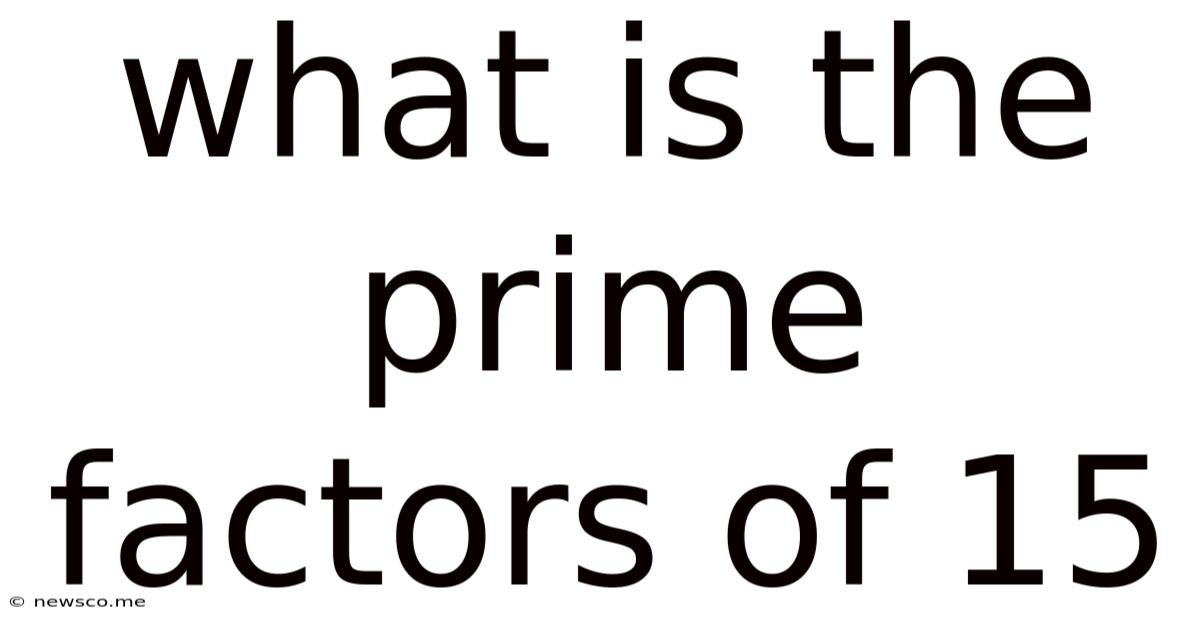What Is The Prime Factors Of 15
News Co
Apr 04, 2025 · 5 min read

Table of Contents
What are the Prime Factors of 15? A Deep Dive into Prime Factorization
Finding the prime factors of a number might seem like a simple arithmetic task, but it's a fundamental concept in number theory with far-reaching implications in mathematics and computer science. This article will delve into the prime factorization of 15, explaining the process in detail and exploring its broader significance. We'll cover what prime numbers are, how to find prime factors, and even touch upon the applications of prime factorization in cryptography and other fields.
Understanding Prime Numbers
Before we tackle the prime factors of 15, let's define what a prime number is. A prime number is a natural number greater than 1 that has no positive divisors other than 1 and itself. This means it's only divisible without a remainder by 1 and itself. The first few prime numbers are 2, 3, 5, 7, 11, 13, and so on. The number 1 is not considered a prime number.
Key characteristics of prime numbers:
- Divisibility: A prime number is only divisible by 1 and itself.
- Infinitude: There are infinitely many prime numbers. This is a fundamental theorem in number theory.
- Building Blocks: Prime numbers are the fundamental building blocks of all other integers greater than 1. This is the essence of prime factorization.
Prime Factorization: The Foundation
Prime factorization is the process of expressing a composite number (a number greater than 1 that is not prime) as a product of its prime factors. Every composite number can be uniquely factored into a product of primes, regardless of the order of the factors. This is known as the Fundamental Theorem of Arithmetic.
This theorem is crucial because it guarantees that there's only one way to express a composite number as a product of primes (excluding the order). This uniqueness is vital in various mathematical applications.
Finding the Prime Factors of 15
Now, let's find the prime factors of 15. We can use a simple method:
-
Start with the smallest prime number, 2: Is 15 divisible by 2? No, because 15 is an odd number.
-
Move to the next prime number, 3: Is 15 divisible by 3? Yes, 15 divided by 3 is 5.
-
Consider the resulting quotient, 5: Is 5 a prime number? Yes, 5 is only divisible by 1 and itself.
Therefore, the prime factorization of 15 is 3 x 5.
We can represent this visually using a factor tree:
15
/ \
3 5
This tree clearly shows that the prime factors of 15 are 3 and 5.
Beyond 15: Exploring Prime Factorization Techniques
While finding the prime factors of 15 is straightforward, larger numbers require more systematic approaches. Here are some common techniques:
1. Trial Division
This method involves systematically dividing the number by each prime number, starting from the smallest, until all prime factors are found. While simple, it can be time-consuming for very large numbers.
2. Factorization Algorithms
For significantly larger numbers, more sophisticated algorithms are necessary. These algorithms, often employed in computer science, include:
- Sieve of Eratosthenes: An efficient algorithm for finding all prime numbers up to a specified integer.
- Pollard's rho algorithm: A probabilistic algorithm used to find small prime factors.
- General Number Field Sieve (GNFS): Currently the most efficient known algorithm for factoring very large numbers. This algorithm is crucial in cryptography.
3. Using a Factorization Calculator
Online calculators can quickly compute the prime factorization of numbers, saving you the manual work. However, understanding the underlying principles remains essential.
Applications of Prime Factorization
The seemingly simple concept of prime factorization has profound applications in various fields:
1. Cryptography
Prime factorization is the cornerstone of many widely used encryption methods, such as RSA (Rivest-Shamir-Adleman). RSA relies on the difficulty of factoring the product of two large prime numbers. The security of RSA depends on the computational infeasibility of factoring extremely large numbers – a task that becomes exponentially harder as the size of the numbers increases.
2. Number Theory
Prime factorization plays a central role in number theory, a branch of mathematics dealing with the properties of integers. Concepts like modular arithmetic, congruences, and Fermat's Little Theorem heavily rely on prime factorization.
3. Computer Science
Prime factorization is used in various algorithms and data structures in computer science. Hashing techniques, for example, often utilize prime numbers to distribute data effectively.
4. Coding Theory
Prime numbers are crucial in designing error-correcting codes, which ensure reliable data transmission in communication systems.
5. Abstract Algebra
Prime numbers are fundamental in abstract algebra, particularly in ring theory and field theory.
Conclusion: The Importance of Prime Factors
The seemingly simple question of "What are the prime factors of 15?" opens the door to a vast and fascinating area of mathematics. Understanding prime factorization is not merely an exercise in arithmetic; it's a cornerstone of number theory and has significant applications in fields ranging from cryptography to computer science. While finding the prime factors of 15 is easy, the underlying principles and their applications have far-reaching implications in the world of mathematics and technology. The seemingly simple 3 x 5 holds a significant place in the broader landscape of number theory and its applications. The seemingly simple concept of prime factorization underpins much of modern cryptography and secure communication. Therefore, grasping this concept well is essential for anyone interested in exploring deeper into mathematics and computer science.
Latest Posts
Related Post
Thank you for visiting our website which covers about What Is The Prime Factors Of 15 . We hope the information provided has been useful to you. Feel free to contact us if you have any questions or need further assistance. See you next time and don't miss to bookmark.